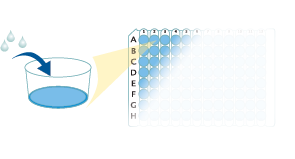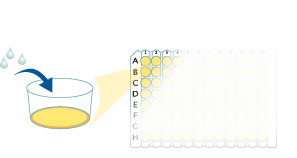Human Fas/TNFRSF6/CD95 Quantikine ELISA Kit
Human Fas/TNFRSF6/CD95 Quantikine ELISA Kit Summary
Product Summary
Precision
Cell Culture Supernates, Serum, EDTA Plasma, Heparin Plasma, Citrate Plasma
| Intra-Assay Precision | Inter-Assay Precision | |||||
|---|---|---|---|---|---|---|
| Sample | 1 | 2 | 3 | 1 | 2 | 3 |
| n | 20 | 20 | 20 | 40 | 40 | 40 |
| Mean (pg/mL) | 130 | 804 | 1424 | 140 | 811 | 1391 |
| Standard Deviation | 5 | 23.3 | 65.2 | 9.4 | 31.8 | 40 |
| CV% | 3.8 | 2.9 | 4.6 | 6.7 | 3.9 | 2.9 |
Recovery
The recovery of Fas/Fc chimera spiked to three different levels throughout the range of the assay in various matrices was evaluated.
| Sample Type | Average % Recovery | Range % |
|---|---|---|
| Cell Culture Media (n=4) | 102 | 92-107 |
| Citrate Plasma (n=5) | 98 | 82-116 |
| EDTA Plasma (n=5) | 97 | 86-111 |
| Heparin Plasma (n=5) | 94 | 88-109 |
| Serum (n=5) | 97 | 91-110 |
Linearity
Scientific Data
Product Datasheets
Preparation and Storage
Background: Fas/TNFRSF6/CD95
Fas (Fibroblast-associated), also known as Apo-1, CD95, and TNFRSF6, was originally identified as a cell-surface protein that binds to monoclonal antibodies that are cytolytic for various human cell lines. Alternatively spliced cDNAs encoding multiple Fas isoforms, including a soluble form of Fas, have been identified. Fas is highly expressed in epithelial cells, hepatocyes, activated mature lymphocytes, virus-transformed lymphocytes and other tumor cells. Fas expression has also been detected in mouse thymus, liver, heart, lung, kidney and ovary.
Assay Procedure
Refer to the product- Prepare all reagents, standard dilutions, and samples as directed in the product insert.
- Remove excess microplate strips from the plate frame, return them to the foil pouch containing the desiccant pack, and reseal.
- Add 100 µL of Assay Diluent to each well.
- Add 100 µL of Standard, control, or sample to each well. Cover with a plate sealer, and incubate at room temperature for 2 hours.
- Aspirate each well and wash, repeating the process 3 times for a total of 4 washes.
- Add 200 µL of Conjugate to each well. Cover with a new plate sealer, and incubate at room temperature for 2 hours.
- Aspirate and wash 4 times.
- Add 200 µL Substrate Solution to each well. Incubate at room temperature for 30 minutes. PROTECT FROM LIGHT.
- Add 50 µL of Stop Solution to each well. Read at 450 nm within 30 minutes. Set wavelength correction to 540 nm or 570 nm.





Citations for Human Fas/TNFRSF6/CD95 Quantikine ELISA Kit
R&D Systems personnel manually curate a database that contains references using R&D Systems products. The data collected includes not only links to publications in PubMed, but also provides information about sample types, species, and experimental conditions.
17
Citations: Showing 1 - 10
Filter your results:
Filter by:
-
Tumor necrosis factor-alpha and Fas/Fas ligand signaling pathways in chronic spontaneous urticaria
Authors: R Grzanka, A Damasiewic, A Kasperska-
Allergy Asthma Clin Immunol, 2019-03-14;15(0):15.
Species: Human
Sample Types: Serum
-
Evaluation of soluble concentration Fas and Fas ligand in maternal and cord blood 3rd trimester of pregnancy
Authors: A Karowicz-B, U Kowalska-K, D Estemberg, A Sikora-Szu
Ginekol. Pol., 2018-01-01;89(3):142-146.
Species: Human
Sample Types: Serum
-
FAS-antisense 1 lncRNA and production of soluble versus membrane Fas in B-cell lymphoma.
Authors: Sehgal, L, Mathur, R, Braun, F K, Wise, J F, Berkova, Z, Neelapu, S, Kwak, L W, Samaniego, F
Leukemia, 2014-04-03;28(12):2376-87.
Species: Human
Sample Types: Cell Culture Supernates
-
High admission glucose levels increase Fas apoptosis and mortality in patients with acute ST-elevation myocardial infarction: a prospective cohort study.
Authors: Chang J, Zhang G, Zhang L, Hou Y, Liu X, Zhang L
Cardiovasc Diabetol, 2013-11-15;12(1):171.
Species: Human
Sample Types: Plasma
-
Effect of quinapril on in-stent restenosis and relation to plasma apoptosis signaling molecules.
Authors: Deftereos S, Giannopoulos G, Kossyvakis C, Kaoukis A, Raisakis K, Driva M, Panagopoulou V, Lappos S, Rentoukas I, Pyrgakis V, Alpert MA
Am. J. Cardiol., 2009-11-14;105(1):54-8.
Species: Human
Sample Types: Plasma
-
Fas expression in conjunctival epithelial cells of patients with cystic fibrosis.
J. Interferon Cytokine Res., 2009-11-01;29(11):735-40.
Species: Human
Sample Types: Serum
-
A 60-s postconditioning protocol by percutaneous coronary intervention inhibits myocardial apoptosis in patients with acute myocardial infarction.
Authors: Zhao WS, Xu L, Wang LF, Zhang L, Zhang ZY, Liu Y, Liu XL, Yang XC, Cui L, Zhang L
Apoptosis, 2009-10-01;14(10):1204-11.
Species: Human
Sample Types: Plasma
-
Prognostic value of apoptosis markers in advanced heart failure patients.
Authors: Niessner A, Hohensinner PJ, Rychli K, Neuhold S, Zorn G, Richter B, Hulsmann M, Berger R, Mortl D, Huber K, Wojta J, Pacher R
Eur. Heart J., 2009-02-04;30(7):789-96.
Species: Human
Sample Types: Plasma
-
Soluble and membrane levels of molecules involved in the interaction between clonal plasma cells and the immunological microenvironment in multiple myeloma and their association with the characteristics of the disease.
Authors: Perez-Andres M, Almeida J, Martin-Ayuso M, De Las Heras N, Moro MJ, Martin-Nunez G, Galende J, Cuello R, Abuin I, Moreno I, Dominguez M, Hernandez J, Mateo G, San Miguel JF, Orfao A
Int. J. Cancer, 2009-01-15;124(2):367-75.
Species: Human
Sample Types: Plasma
-
Effects of darbepoetin-alpha on plasma pro-inflammatory cytokines, anti-inflammatory cytokine interleukin-10 and soluble Fas/Fas ligand system in anemic patients with chronic heart failure.
Authors: Kourea K, Parissis JT, Farmakis D, Panou F, Paraskevaidis I, Venetsanou K, Filippatos G, Kremastinos DT
Atherosclerosis, 2007-11-07;199(1):215-21.
Species: Human
Sample Types: Plasma
-
Soluble Fas--a promising novel urinary marker for the detection of recurrent superficial bladder cancer.
Authors: Svatek RS, Herman MP, Lotan Y, Casella R, Hsieh JT, Sagalowsky AI, Shariat SF
Cancer, 2006-04-15;106(8):1701-7.
Species: Human
Sample Types: Urine
-
Growth hormone-induced reduction of soluble apoptosis mediators is associated with reverse cardiac remodelling and improvement of exercise capacity in patients with idiopathic dilated cardiomyopathy.
Authors: Parissis JT, Adamopoulos S, Karatzas D, Paraskevaidis J, Livanis E, Kremastinos D
Eur J Cardiovasc Prev Rehabil, 2005-04-01;12(2):164-8.
Species: Human
Sample Types: Plasma
-
High-dose glucose-insulin-potassium treatment reduces myocardial apoptosis in patients with acute myocardial infarction.
Authors: Zhang L, Li YH, Zhang HY, Chen ML, Gao MM, Hu AH, Yang HS
Eur. J. Clin. Invest., 2005-03-01;35(3):164-70.
Species: Human
Sample Types: Plasma
-
Escape from cardiomyocyte apoptosis by enterovirus persistence due to elevated soluble Fas-receptors.
Authors: Alter P, Maisch B
Z Kardiol, 2004-07-01;93(7):524-32.
Species: Human
Sample Types: Serum
-
Nitric oxide is associated with poor embryo quality and pregnancy outcome in in vitro fertilization cycles.
Authors: Lee TH, Wu MY, Chen MJ, Chao KH, Ho HN, Yang YS
Fertil. Steril., 2004-07-01;82(1):126-31.
Species: Human
Sample Types: Follicular Fluid
-
Level of sFas/APO 1 in serum and cerebrospinal fluid in multiple sclerosis.
Authors: Mahovic D, Petravic D, Petelin Z, Zurak N, Horvat G, Hajnsek S
Clin Neurol Neurosurg, 2004-06-01;106(3):230-2.
Species: Human
Sample Types: Serum
-
Evaluation of caspase 1 and sFas serum levels in patients with systemic sclerosis: correlation with lung dysfunction, joint and bone involvement.
Authors: Dziankowska-Bartkowiak B, Waszczykowska E, Zalewska A, Sysa-Jedrzejowska A
Mediators Inflamm., 2003-12-01;12(6):339-43.
Species: Human
Sample Types: Serum
FAQs
No product specific FAQs exist for this product, however you may
View all ELISA FAQsReviews for Human Fas/TNFRSF6/CD95 Quantikine ELISA Kit
Average Rating: 5 (Based on 1 Review)
Have you used Human Fas/TNFRSF6/CD95 Quantikine ELISA Kit?
Submit a review and receive an Amazon gift card.
$25/€18/£15/$25CAN/¥75 Yuan/¥2500 Yen for a review with an image
$10/€7/£6/$10 CAD/¥70 Yuan/¥1110 Yen for a review without an image
Filter by:









